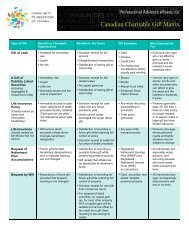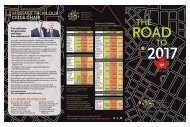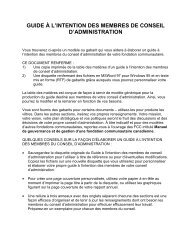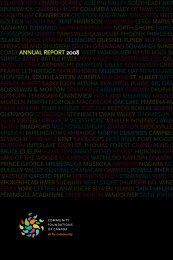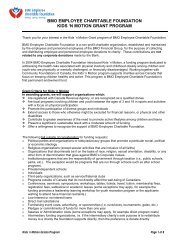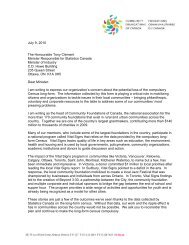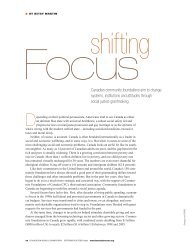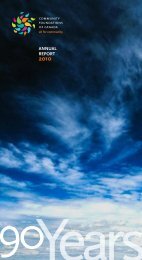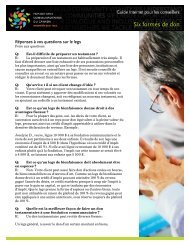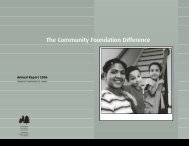Aboriginal Philanthropy in Canada: A Foundation for Understanding
Aboriginal Philanthropy in Canada: A Foundation for Understanding
Aboriginal Philanthropy in Canada: A Foundation for Understanding
You also want an ePaper? Increase the reach of your titles
YUMPU automatically turns print PDFs into web optimized ePapers that Google loves.
Community Perspectives<br />
Seven key stakeholders were <strong>in</strong>terviewed <strong>for</strong> this<br />
case study; five were residents of Moose Deer Po<strong>in</strong>t<br />
and provided their perspectives on the difference<br />
Niigon has made <strong>in</strong> the community. One respondent<br />
who was among the first group of tra<strong>in</strong>ees at Humber<br />
College stated:<br />
“The development of Niigon has meant options, that<br />
community members have options – previous to this,<br />
post-secondary students knew that because there<br />
wouldn’t be employment opportunities at home, they<br />
would have to live elsewhere, but now they have that<br />
option to come home and work. Also, it’s busy - there<br />
are programs and events virtually every even<strong>in</strong>g <strong>in</strong> the<br />
community.”<br />
Accord<strong>in</strong>g to this respondent, approximately 70<br />
per cent of community high school students graduate<br />
and the community is provid<strong>in</strong>g <strong>in</strong>centives to improve<br />
this rate. This number is significantly better than the<br />
national average of 50 per cent <strong>for</strong> <strong>Aborig<strong>in</strong>al</strong> students,<br />
though still far below the 90 per cent average <strong>for</strong> non-<br />
<strong>Aborig<strong>in</strong>al</strong> youth.<br />
Another resident said that Niigon has <strong>in</strong>creased<br />
community pride:<br />
“We know that it is ours, and it isn’t someth<strong>in</strong>g that<br />
can be taken away… it belongs to the First Nation and<br />
is community-driven… There is a recognition of the<br />
First Nation as a serious bus<strong>in</strong>ess partner. The Niigon<br />
Board of Directors was <strong>in</strong>tended to be comprised of<br />
experts, not just <strong>in</strong> <strong>in</strong>ject<strong>in</strong>g mould<strong>in</strong>g, but <strong>in</strong> bus<strong>in</strong>ess<br />
as well, solidify<strong>in</strong>g its reputation as a major area<br />
bus<strong>in</strong>ess player. Our community has had a positive<br />
effect on the local economy – this is another dimension<br />
of relationship-build<strong>in</strong>g. MDPFN has established a<br />
protocol agreement regard<strong>in</strong>g the environment with<br />
other surround<strong>in</strong>g communities. The impact of Niigon<br />
is that we’re taken seriously. Not that we had a [poor]<br />
relationship be<strong>for</strong>e… [but now] they believe when we<br />
say someth<strong>in</strong>g is go<strong>in</strong>g to happen, it’s go<strong>in</strong>g to happen.”<br />
The employment, education and tra<strong>in</strong><strong>in</strong>g available<br />
to community members through Niigon is pay<strong>in</strong>g off <strong>in</strong><br />
significant ways. For example, one of the women among<br />
the first group of tra<strong>in</strong>ees received additional tra<strong>in</strong><strong>in</strong>g<br />
<strong>in</strong> quality assurance followed by an <strong>in</strong>ternship at Husky<br />
<strong>in</strong> Toronto. She worked <strong>in</strong> Niigon <strong>for</strong> a number of years<br />
be<strong>for</strong>e mov<strong>in</strong>g away from the community <strong>for</strong> a time.<br />
Now she has returned to Moose Deer Po<strong>in</strong>t to use the<br />
skills she learned at Humber and honed at Niigon as the<br />
Director of the new water treatment facility.<br />
Karen Little Child, Niigon Technologies Quality<br />
Assurance Manager, was another of the first group<br />
of tra<strong>in</strong>ees. The development of Niigon brought her<br />
back to the community and she wants to see this work<br />
<strong>in</strong> other First Nations. Little Child said that the goals<br />
of mak<strong>in</strong>g the community more susta<strong>in</strong>able and giv<strong>in</strong>g<br />
back to the community have been met to some degree,<br />
though there have been challenges along the way. She<br />
expla<strong>in</strong>ed:<br />
“Some difficulties that the community employees have<br />
had to deal with <strong>in</strong>clude work<strong>in</strong>g night shifts, weekends<br />
and 12 hour shifts; however, to make this work, they<br />
have had to deal with these issues, because this is a<br />
bus<strong>in</strong>ess. It was difficult to expla<strong>in</strong> time keep<strong>in</strong>g… there<br />
is a different understand<strong>in</strong>g of fund<strong>in</strong>g and money…<br />
there was a relationship of dependency there that we<br />
just can’t af<strong>for</strong>d here. The community needs to work,<br />
work hard, and work smart.”<br />
Little Child’s comments underl<strong>in</strong>e an <strong>in</strong>herent culture<br />
clash between the cultures of dependency that have<br />
developed <strong>in</strong> First Nations <strong>in</strong> response to colonization<br />
and the Indian Act and the culture of post-<strong>in</strong>dustrial<br />
work. The tensions of this clash do not reflect the<br />
ability, skills or desire of First Nations people <strong>in</strong> Moose<br />
Deer Po<strong>in</strong>t or other communities, but rather the need to<br />
learn what is needed <strong>in</strong> a post-<strong>in</strong>dustrial world of work.<br />
Little Child recognized that “some with<strong>in</strong> the<br />
community felt that we would lose our identity, but<br />
we haven’t, and we made sure we didn’t,” s<strong>in</strong>ce the<br />
community and the Schad <strong>Foundation</strong> shared the goal<br />
of Niigon be<strong>in</strong>g <strong>in</strong>dependent. Another challenge has<br />
been that Niigon has not made progress as quickly as<br />
they wanted, and understand<strong>in</strong>g that the entire process<br />
takes time. Niigon cont<strong>in</strong>ues to offer tra<strong>in</strong><strong>in</strong>g groups<br />
based on <strong>in</strong>terest and need; each group receives<br />
tra<strong>in</strong><strong>in</strong>g on every aspect of the bus<strong>in</strong>ess to give them an<br />
understand<strong>in</strong>g of how everyth<strong>in</strong>g works.<br />
The Circle on <strong>Philanthropy</strong> & <strong>Aborig<strong>in</strong>al</strong> Peoples <strong>in</strong> <strong>Canada</strong> 40



